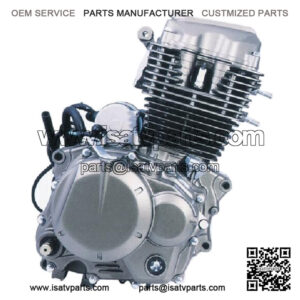n All-Terrain Vehicle (ATV) engine refers to the power source that drives the vehicle. It is the internal combustion engine responsible for generating the mechanical energy required to propel the ATV forward. ATVs typically use small engines designed for off-road use.
Here are some key features and characteristics of ATV engines:
- Size and Displacement: ATV engines are usually compact and lightweight, designed to fit within the frame of the vehicle. The engine’s displacement refers to the total volume displaced by the engine’s pistons during a complete cycle, typically measured in cubic centimeters (cc) or cubic inches (ci). ATV engines can range in displacement from around 50cc for smaller youth models to several hundred cc for larger adult models.
- Type: Most ATVs are powered by four-stroke engines, which are more fuel-efficient and produce less noise compared to two-stroke engines. Four-stroke engines have separate intake, compression, combustion, and exhaust strokes, providing smoother power delivery and better low-end torque. However, some smaller ATVs may use two-stroke engines due to their simplicity and lighter weight.
- Fuel: ATV engines commonly run on gasoline (petrol), similar to other small vehicles. However, there are also electric ATVs available that use electric motors and rechargeable batteries as their power source, eliminating the need for gasoline.
- Cooling: ATV engines require cooling mechanisms to dissipate the heat generated during operation. Air-cooled engines use fins and a fan to cool the engine, while liquid-cooled engines use a coolant that circulates through the engine and a radiator.
- Power Output: The power output of an ATV engine is typically measured in horsepower (HP) or kilowatts (kW). The power output can vary depending on the engine’s design, size, and intended use. Smaller ATVs designed for kids may have engines with lower power output, while larger adult models may have engines capable of producing higher horsepower for increased performance.
It’s important to note that ATV engines require regular maintenance, including oil changes, filter replacements, and periodic tune-ups, to ensure optimal performance and longevity. Additionally, ATV engines should be operated within the manufacturer’s recommended guidelines and safety precautions.
The function of an all-terrain vehicle (ATV) engine is to provide the necessary power and propulsion for the vehicle to operate in various off-road conditions. The engine is responsible for converting fuel (usually gasoline) into mechanical energy to drive the ATV’s wheels.
Here are some key functions of an ATV engine:
- Power Generation: The engine generates power by burning fuel in a combustion chamber. This power is transmitted to the transmission system, which transfers it to the wheels, propelling the ATV forward.
- Combustion Process: The engine mixes air and fuel in the combustion chamber, ignites the mixture with a spark from the spark plug, and creates controlled explosions. These explosions push the engine’s pistons, which convert the linear motion into rotational motion.
- Cooling: The engine has a cooling system to prevent overheating. It typically utilizes a radiator, coolant, and a fan to dissipate excess heat generated during the combustion process.
- Lubrication: Engines require proper lubrication to reduce friction and prevent wear and tear on the moving parts. Oil is circulated throughout the engine to lubricate the pistons, crankshaft, and other components.
- Intake and Exhaust: The engine has an intake system that draws air and fuel into the combustion chamber, and an exhaust system that expels the burned gases. This cycle allows for fresh air-fuel mixture intake and efficient removal of waste gases.
- Power Output Control: The engine may have various mechanisms for controlling the power output, such as a throttle. The throttle controls the amount of air and fuel entering the engine, allowing the rider to adjust the ATV’s speed and acceleration.
It’s important to note that the specific design and features of an ATV engine can vary depending on the manufacturer, model, and intended use of the vehicle. Different engines may have different displacements, power outputs, and additional features to suit specific ATV applications.
About All-Terrain Vehicle (ATV) engine
atlas all-terrain vehicle
m-atv vehicle
extreme all-terrain vehicles
yamaha all-terrain vehicles
z-mag all-terrain vehicle

